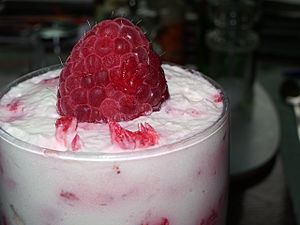Fruit fool facts for kids

A raspberry fool
|
|
| Alternative names | Foole |
|---|---|
| Course | Dessert |
| Place of origin | England |
| Main ingredients | Puréed fruit, whipped cream, sugar |
| Variations | Trifle |
A fool is a yummy and simple dessert from England! It's usually made by mixing cooked, mashed fruit with something creamy. Traditionally, people used sweet custard, especially with gooseberries. But today, many recipes use light and fluffy whipped cream instead. Sometimes, a special flavor like rose water is added to make it even more delicious!
Contents
Discovering the History of Fool Dessert
The dessert called Foole was first written about in 1598. Back then, it was made with a thick cream called 'clouted creame'. Some people think that gooseberry fool, a popular type, might have been around even earlier, perhaps in the 1400s! The very first recipe for fruit fool that we know of appeared in the mid-1600s.
Why is it Called "Fool"?
It's a bit of a mystery why this creamy fruit dessert is called "fool." Some people thought the name came from the French word fouler, which means "to crush" or "to press," like when grapes are pressed for wine. However, experts at the Oxford English Dictionary say this idea isn't correct. For a while, this dessert was also sometimes called "trifle," and the two names were used for similar dishes.
Tasty Variations of Fruit Fool
Originally, the most common fruit used in a fool was gooseberry. But old recipes also show that people used other fruits and berries like apples, strawberries, rhubarb, and raspberries. Today, you can make a fool with almost any fruit that's in season. Even with all these choices, gooseberry fool is still a favorite for many!
Norfolk Fool: A Local Twist
There's an old local version of this dessert called Norfolk fool. In this recipe, the fruit seems to be less important than the creamy part. It's often added right at the very end of the cooking process.


